Why you can trust Tom's Hardware
AMD's desktop Ryzen 4000 "Renoir" APUs mark a big step forward in application performance thanks to the 7nm Zen 2 architecture, while the integrated Radeon RX Vega graphics enable smooth FHD gaming if you're willing to accept lower fidelity settings and a limited selection of titles. The chips also deliver comparatively exceptional performance in 1280x720 gaming.
AMD's decision to target the OEM and SI pre-built markets with these chips makes good business sense, but enthusiasts and DIY'ers pining for more powerful APUs can't help but feel left out. As usual, supply will typically pop up where there's plenty of demand, so we were able to score a Ryzen 7 Pro 4750G at a distributor.
Aside from the performance-impacting memory encryption feature, our Pro model is the functional equivalent of the consumer-focused Ryzen 7 4700G. We simply disabled the encryption feature (TSME) to see what the Ryzen 7 4700G would look like in our standard tests. The charts below outline three areas of performance: The geometric mean of our suite of integrated graphics tests at both 1920x1080 (FHD) and 1280x720 resolutions, the geometric mean of performance with a discrete GPU, and performance in single- and multi-threaded workloads.
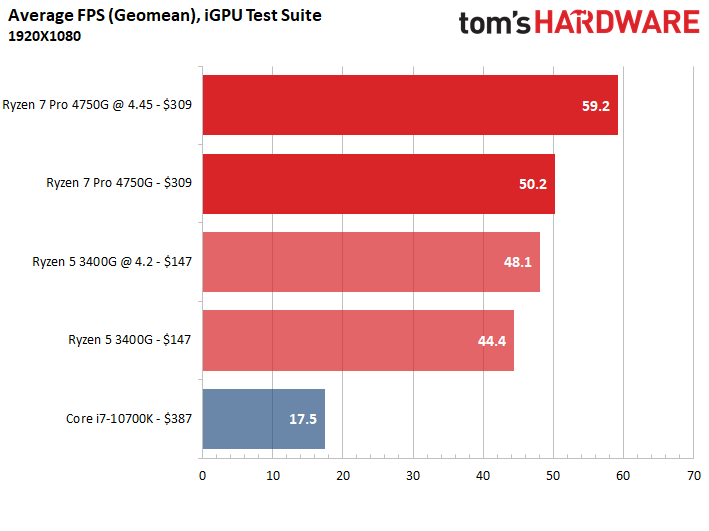
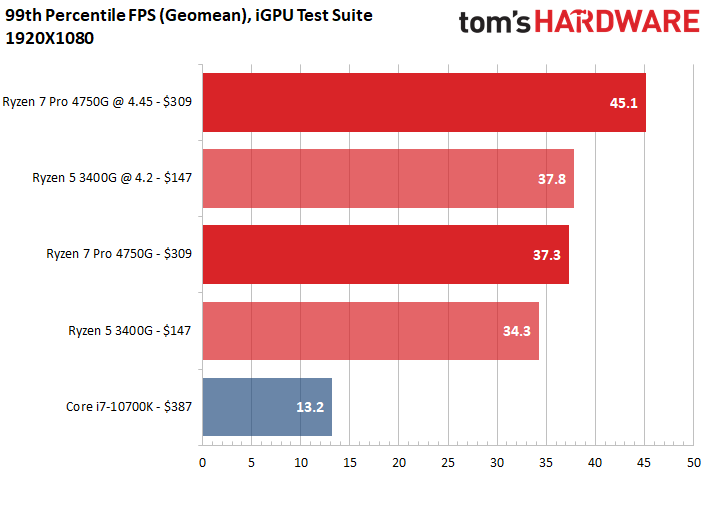
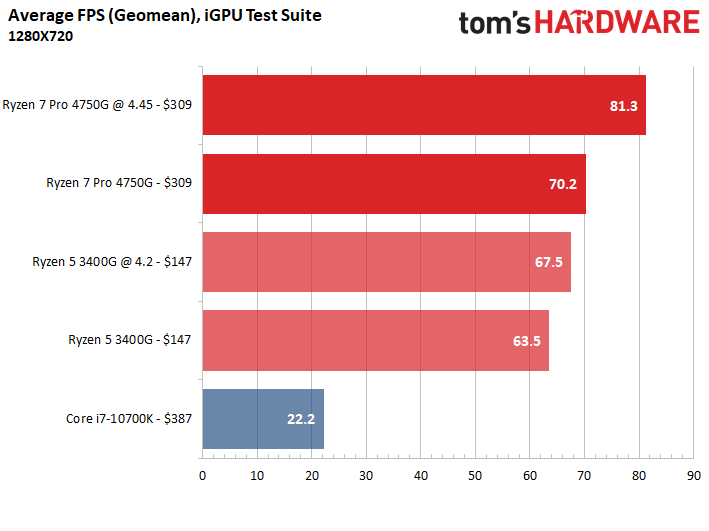
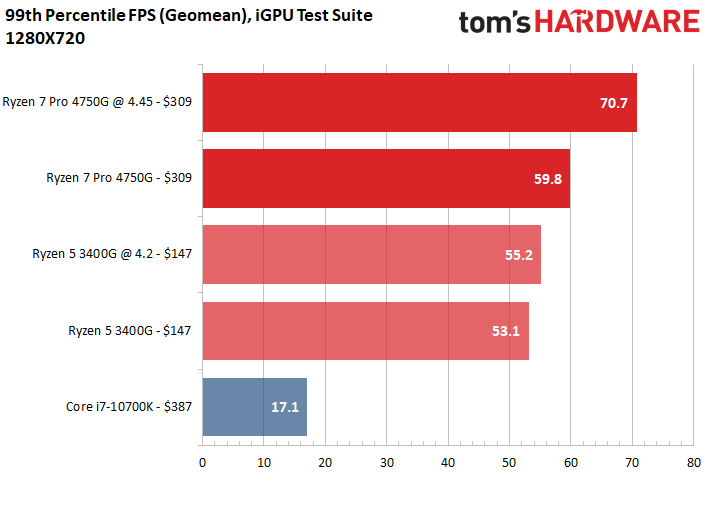
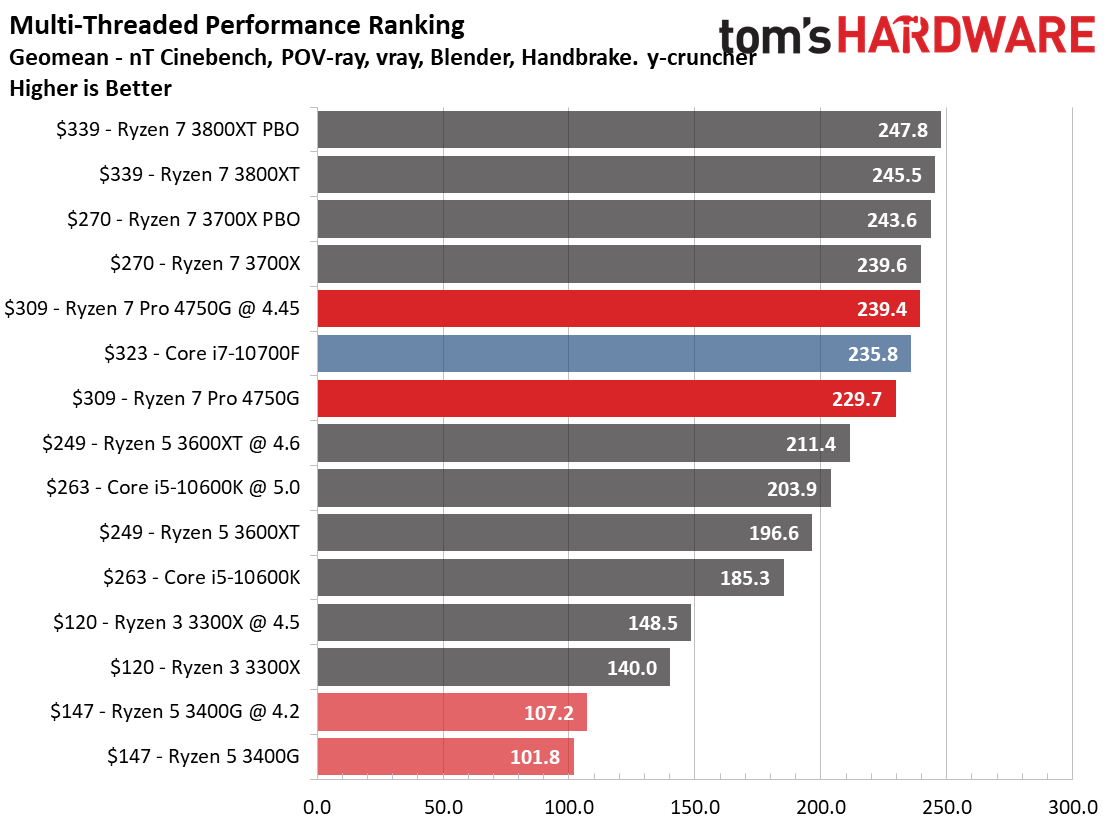
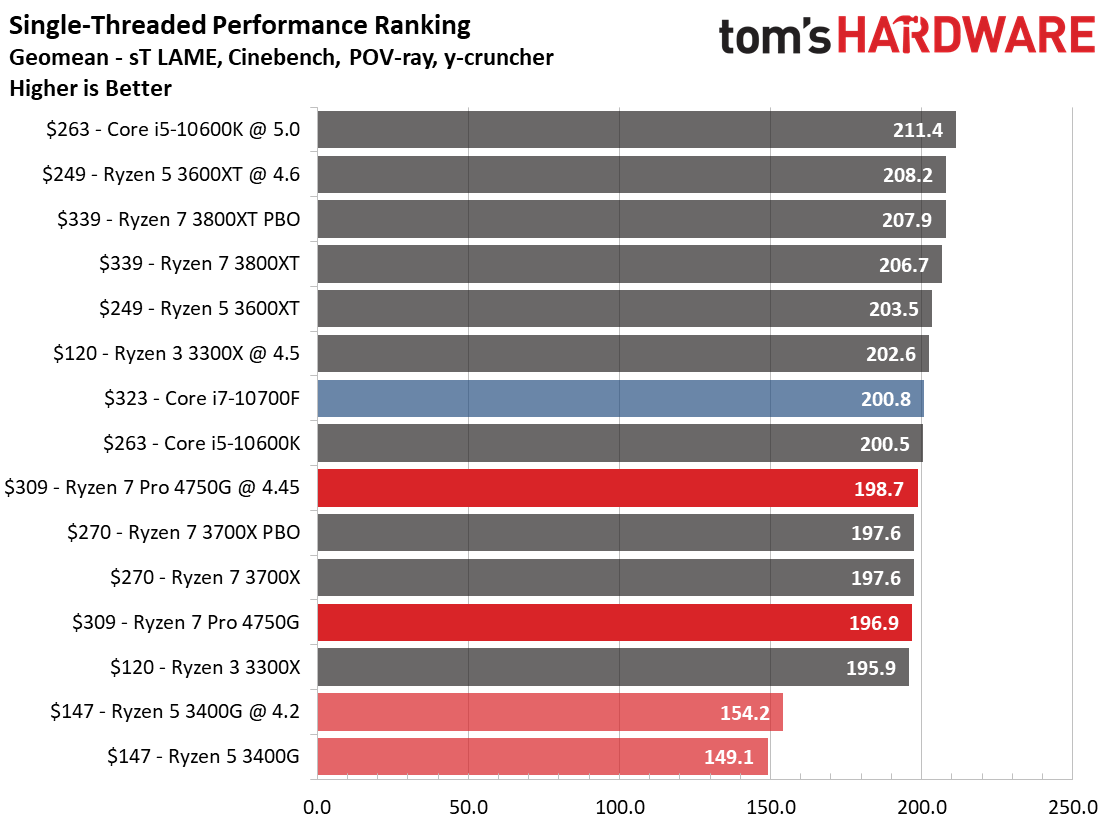
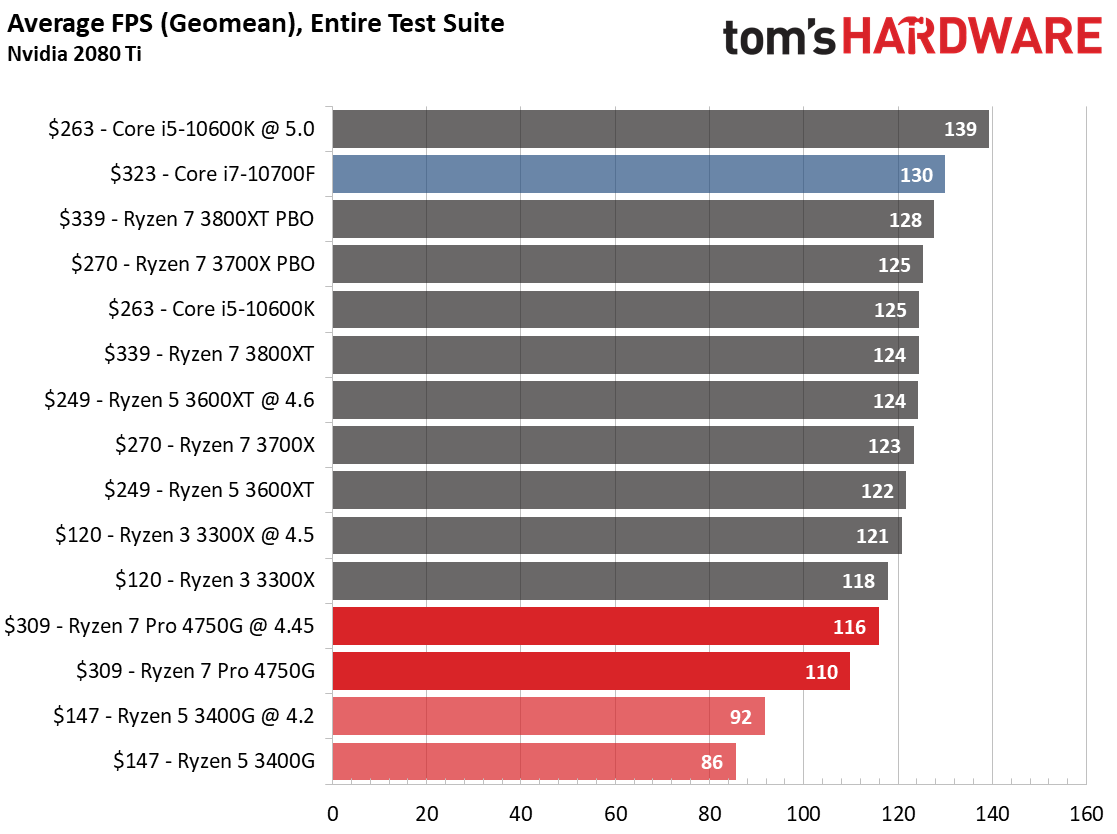
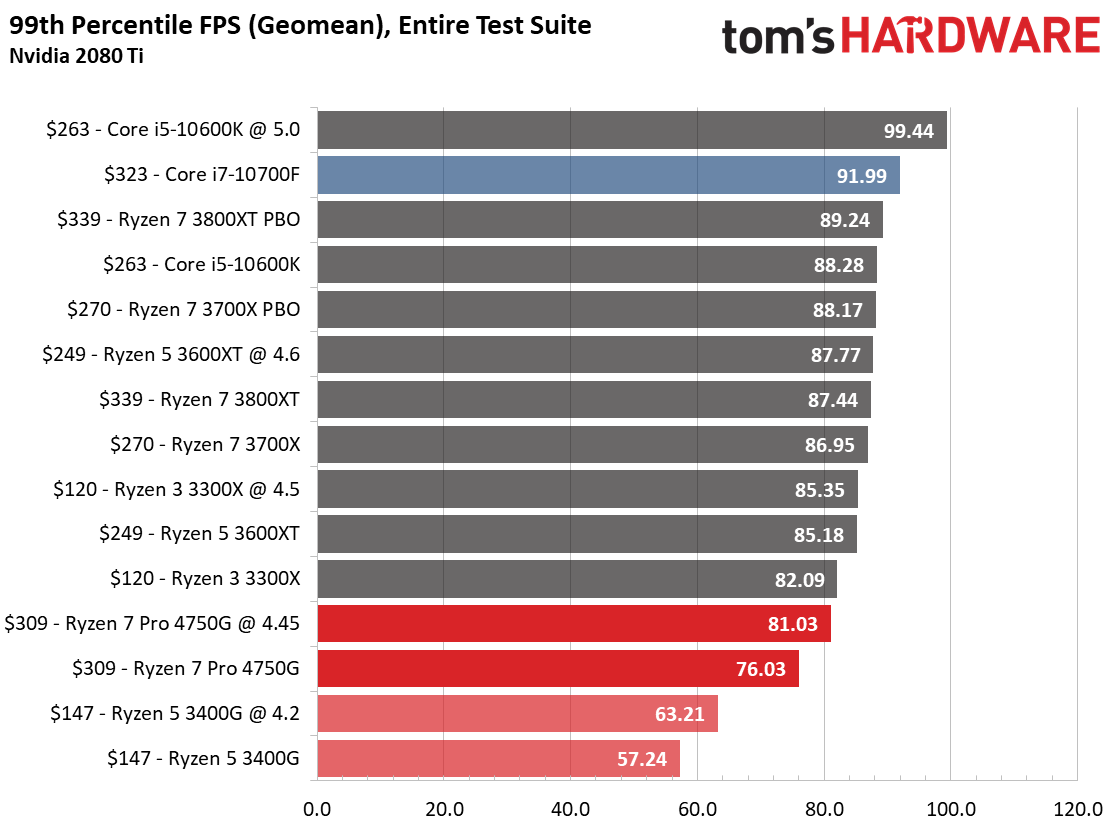
If you're after the utmost in integrated graphics performance, the Renoir chips are undoubtedly the new king of the hill. At stock settings, the 4750G's Vega graphics engine performs roughly in line with the overclocked previous-gen Ryzen 5 3400G. After overclocking, the tuned 4750G beats the OC'd 3400G by 23% at the FHD resolution, and by 20% at 1280x720. Meanwhile, the stock Ryzen 7 4750G destroys the Core i7-10700K's UHD Graphics 630 with roughly three times as much performance with the tested FHD and 1280x720 games. After overclocking, the 4750G stretches that advantage to roughly 3.5X.
Turning to performance in desktop applications, the Ryzen 7 Pro 4750G offers 32% faster performance in single threaded workloads than the 3400G, and trails the Core i7-10700F by a mere 1%. In threaded workloads, the Ryzen 7 Pro 4750G delivers more than twice the performance of the Ryzen 5 3400G and trails the 10700F by 2.6%. Overall, Renoir represents a massive generational leap for AMD APUs in both multi- and single-threaded performance, and Intel doesn't hold any clear wins in applications that would drastically impact the purchasing decision for most users.
However, enthusiasts interested in pairing a Ryzen 4000 Renoir APU with a discrete GPU are better served looking elsewhere. AMD's own Ryzen 3 3300X provides more performance at a lower price point. Ultimately the 4750G suffers at the hands of its comparatively small 8MB cache, while the 3300X benefits from 16MB. AMD's "GameCache" marketing may seem hokey, but L3 cache capacity clearly has a big impact on Zen 2's performance in latency-sensitive workloads, like gaming. The 3300X makes a better fit for low-end systems with discrete graphics, or you could pick up a Ryzen 5 3400G for a mere $147 if you're after a less-expensive APU alternative.
Renoir makes a compelling part for small form factor and HTPC builders, and it's also the only option for pairing an APU with a B550 motherboard. Unfortunately, the chips currently sell for inflated pricing through distributors, and warranty support might vary. For instance, while the Ryzen 7 Pro 4750G unofficially commands a $309 price point, we paid $353 for our chip. As such, you can expect to see higher pricing in the grey market than we have listed in the charts, especially if price gouging takes hold. And unlike most of AMD's retail chips, it likely won't come with a bundled cooler without an upcharge. That certainly muddies the value proposition.
Get Tom's Hardware's best news and in-depth reviews, straight to your inbox.
The Renoir chips are exceptional overclockers with plenty of room for fine-grained tuning, so we expect that some enthusiasts may pick up a chip just to tinker. But be aware that you'll need a beefy liquid cooler and capable memory kit to match our relatively high overclocks.
The combination of leading integrated graphics and very competitive application performance makes for a compelling part for OEMs and system integrators. Whereas the previous-gen Picasso APUs topped out at four cores, Renoir allows AMD to counter the Intel Core i3, i5, and i7 families with competitive parts in a critical part of the high-volume pre-built consumer desktop market. Meanwhile, the professional features with the Pro series address the needs of professional organizations.
For the rest of us, outside of a narrow cross-section of SFF and HTPC builders (and fanatical tuners), the Renoir desktop APUs don't make a lot of sense — largely because they aren't available at retail at reasonable prices. For dedicated GPU use, you'll often get better performance out of the Ryzen 7 3700X, thanks to its large 32MB L3 cache, at a lower price.
AMD says it has "next-gen" APUs for 400- and 500-series motherboards coming in the future, and Zen 3 processors will come later this year. It would be great to see Zen 3 launch with integrated solutions as well, but that's probably asking too much. Either way, it's probably best to wait and see what comes next rather than buying an OEM-only Renoir desktop chip right now.
Current page: Promising, But Out of Reach
Prev Page AMD Ryzen 7 Pro 4750G Application Benchmarks
Paul Alcorn is the Editor-in-Chief for Tom's Hardware US. He also writes news and reviews on CPUs, storage, and enterprise hardware.
-
mdd1963 I expected /hoped for a bit more than bumping FPS in games up only 10-15% compared to the 3400G.... (Apparently I will not be happy until they can match GTX1060-level of performance into the APU)Reply -
neojack impressive results ! this APU is more powerfull than my 2700x in raw power, AND has an igpu about equal to a gtx 1050Reply -
JarredWaltonGPU Reply
It's a bit weird, because the memory bandwidth is lower but all system RAM can be treated as shared VRAM, so you can sometimes run higher settings with less performance problems on in integrated Vega 8 GPU than on a dedicated GPU. But in general, Vega 8 for Renoir is roughly equal to an RX 560, which is basically equal to a GTX 1050.Gurg said:Curious as to which discrete GPU the iGPU is the equivalent.
In a lot of cases, the 1050 is still 25% faster, though. For example, Far Cry 5 1080p normal settings, I got 43 fps, Shadow of the Tomb Raider 1080p Medium I got 39 fps, and Strange Brigade 1080p medium I got 72 fps. That means the GTX 1050 beat the integrated 4750G's Vega 8 Graphics, even when the latter was overclocked. And the GTX 1050 is a pretty slow GPU by today's standards -- the GTX 1650 Super is over twice as fast as the GTX 1050. -
Gurg Reply
Thanks for the reply. It seems like a CPU/iGPU for a $1,000 laptop without a discrete GPU.JarredWaltonGPU said:It's a bit weird, because the memory bandwidth is lower but all system RAM can be treated as shared VRAM, so you can sometimes run higher settings with less performance problems on in integrated Vega 8 GPU than on a dedicated GPU. But in general, Vega 8 for Renoir is roughly equal to an RX 560, which is basically equal to a GTX 1050.
In a lot of cases, the 1050 is still 25% faster, though. For example, Far Cry 5 1080p normal settings, I got 43 fps, Shadow of the Tomb Raider 1080p Medium I got 39 fps, and Strange Brigade 1080p medium I got 72 fps. That means the GTX 1050 beat the integrated 4750G's Vega 8 Graphics, even when the latter was overclocked. And the GTX 1050 is a pretty slow GPU by today's standards -- the GTX 1650 Super is over twice as fast as the GTX 1050. -
Neilbob Replynofanneeded said:"Useless"
no 4th GEN PCIe means no one will buy it.
I agree. This is why Intel is unable to sell a single CPU! A computer without 4th GEN PCIe capability might as well be a brick, right?
(Sarcasm, just in case there's doubt) -
nofanneeded ReplyNeilbob said:I agree. This is why Intel is unable to sell a single CPU! A computer without 4th GEN PCIe capability might as well be a brick, right?
(Sarcasm, just in case there's doubt)
At least intel offers 16 lanes with their CPU . This chips only offers 8 lanes Gen3 .. useless. -
Neilbob Replynofanneeded said:At least intel offers 16 lanes with their CPU . This chips only offers 8 lanes Gen3 .. useless.
I would say 'limiting' rather than useless. Especially seeing as these APUs are intended for an OEM market that in all likelihood won't be pairing them with anything more than a mid-range GPU (that's what the Ryzen 3000 series is for).
Who's to say that more lanes won't be exposed if/when AMD release these for the DIY user base?
Of course, this is just pure speculation from me. Already got my 3600 so I'm all set either way (y)
Edit: So there actually are 16 lanes (which I missed in the review) so above posts turn out to be irrelevant.